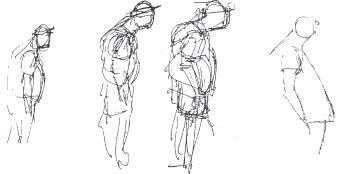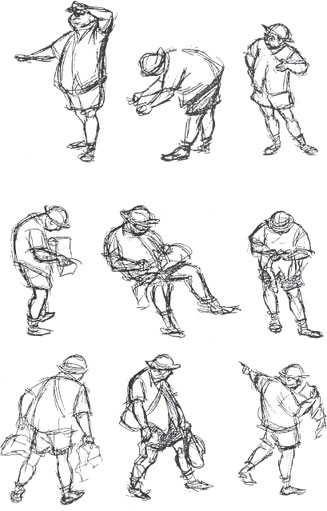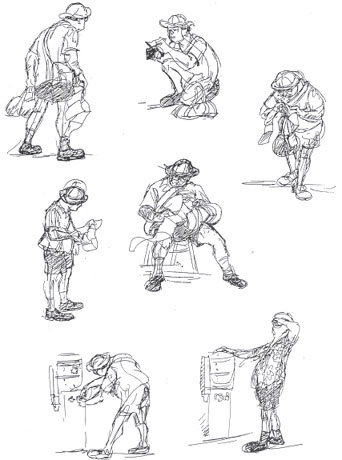Drawing techniques vary from person to person, which is as it should be. One should feel comfortable and as free as possible while drawing. This is one case where the means is justifiable if the end is achieved. And as we all agree (I insist on it) the end is a good “storytelling drawing.” It could be though that if you’re not achieving the “end,” your means may be faulty. And if this is the case, some adjustments are in order. Most of us tend to unthinkingly fall into habit patterns (good or bad) that as soon as they take hold, seem normal. So it’s sometimes difficult to spot our own— how shall I say — shortcomings.
Technique seems to imply a surface attribute. But according to Webster’s Collegiate Dictionary the word actually means “the method or the details of procedure essential to expertness of execution in any art, science, etc.,” and so has to do with any function that goes into the drawing, including the mental. The mental part is the desire, inspiration, concentration, and sustained interest.
Many times I have (as I “stalk” behind the artists in our evening class) watched someone start a drawing and sensing it was not coming up right, abandon it and start again — only to do the very same thing. I have seen as many as five or six starts that looked like Xerox copies. Here is a six-starter and below that a three-starter with my suggestions following. The first one didn’t feel good to the artist because the figure wasn’t leaning over far enough to put some weight on the elbows. I think habit drove him to repeat the “shortcoming.” To chip away at those habits one has to keep the mind flexible at all times. Don’t let some behavior pattern control your act of drawing. A good formula for overcoming those devitalizing habits is to talk to yourself as you draw. Say, “The guy is bending over and is leaning with all the weight of his head shoulders, and upper back on his elbows. I know what a straight line looks like — it looks like this:
![]()
and I know what a bent line looks like — it looks like this:
![]()
so I will use a bent line for the guy’s back so I can get some weight on his elbows.”

In this second group the artist was trying get the stoop-shoulder look, plus a belly protrusion. What he might have said as he talked his drawing into being was, “Okay, the belly is protruding. That’s a verb. So to make it protrude, I’ll thrust it out, putting some tension between the elbow and the belly, let the shirt hang over to accent the protrusion. I’ll even look up into the sleeve, as if it were coming at me, because he’s as wide as he is potbellied, causing the arm to fan out toward me.”

It may seem cumbersome as you read my suggestion but while drawing this all happens in an instant. Logic has a way of cutting through any ponderous cogitation. My sketches are much more simple and direct which has nothing to do with technique — it has to do with thinking and seeing. I simply distill the essence of the gesture and leave everything else out.
In animation, technique has been a relatively controllable variable. All animators draw a little differently, but thanks to an excellent cleanup crew, the drawings are all brought “on model,” and the result is it appears like one person did the whole picture.
Here are two techniques that are very different, on the surface, that is. The first is Kent Culotta’s technique. His drawings are carefully built up from the inside out with layer upon layer of graphite. The searching for the gesture is really done in the mind first — not on the paper. The searching lines on the paper are more to find the final statement.

The second group of drawings is these nice, crisp pen sketches that appear, at casual glance, to be more spontaneous. Yet if a cleanup person was called upon to bring both sets “on model,” the same spark and flair and basic gesture would be present in both groups, regardless of the artist’s techniques. Model Craig Howell’s personality, mannerisms, and his play-acting as a “tourist,” would be there, too, as they so unmistakably are in these drawings.
So as you employ your “technique,” make sure that your definition includes the basics of drawing — not just the superficial appearance of the drawing. Robert Henri, in his book, Art Spirit, advised his students (and us) to
…start with a deep impression; the best, the most interesting, the deepest you can have of the model; to preserve this vision throughout the work; to see nothing else; to admit of no digression from it; choosing only from the model the signs of it; will lead to an organic work. Every element in the picture will be constructive of an idea, expressive of an emotion. Every factor in the painting (drawing) will have beauty because in its place in the organization it is doing its living part. Because of its adjustment, it is given its greatest power of expansion. It is only through a sense of the right relation of things that freedom can be obtained.
Which brings to mind the second sentence in this “handout,” and I quote myself: “One should feel comfortable and as free as possible while drawing.”

